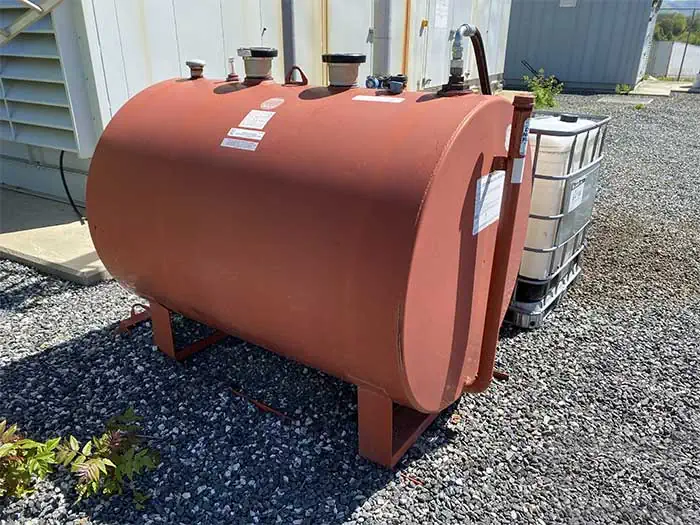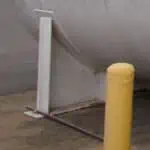


Unexpectedly replacing a tank can strain your budget and always seems to come at the most inopportune times. Based on my experience with tank inspections, one of the most common reasons for unexpected tank replacements is using an Underground Storage Tank (UST) as an Aboveground Storage Tank (AST).
Any STI/SPFA SP001 Certified Inspector can identify a misused UST during the required periodic inspections of ASTs, and these tanks are also commonly discovered during site visits related to drafting or updating Spill Prevention, Control, and Countermeasure (SPCC) Plans. Budget and complete a tank replacement before your next inspection. During my inspections, I use three indicators when looking at a tank to identify if a UST is misused as an AST:
No Emergency Vent! The most important reason not to use a UST aboveground.
If the unthinkable happens and you have a fire around your tank without proper emergency venting, that tank fire can go from bad to BOOM!
The design of ASTs is to minimize the danger of being engulfed in flames to release the vapors from the tank in a controlled manner. In contrast, a UST design will never be engulfed in flames, so the tank manufacturer does not install an emergency vent port.
Properly sizing an AST emergency vent to release the increased vapor pressure during a fire is important, too. The need to release the higher pressure makes emergency vents much larger than the normal vents for simple atmospheric changes. The larger emergency vents come in five varieties:
Flip-up vents are spring-loaded caps held closed by a latch designed to release at a set pressure or temperature. If the latch doesn’t work and the flip-up cap is open, duct tape or a well-placed brick is not the proper solution; you’ll need to replace the latch. Luckily, the latches are readily available, and the latch installation is usually simple.
Rupture disks are vent covers where the entire cover breaks open when a set pressure or temperature is exceeded, instead of just the latch like in the flip-up vents.
Pop-up vents are weighted caps that sit on the vent until the pressure in the tank reaches the designed level. During fire incidents, these vents periodically release the built-up vapors, preventing the tank from rupturing. If this vent is not staying seated correctly, repair or replace the vent.
Long bolt manholes function similarly to the pop-up vents to periodically release built-up vapors. This type of vent relies on the bolts securing the manhole cover to have the designed amount of slack between the manhole rim and the nuts. I’ve seen too many long bolt manholes with the nuts fully tightened to the rim, completely negating the vent’s purpose and safety. A simple fix for this issue is to replace the fully threaded bolts with properly sized partially threaded bolts.
New tanks are unlikely to have Weak Roof-to-Shell joints. Occasionally, I’ve seen them in older single-wall vertical tanks, where the roof construction has a particular area break when the tank pressure gets too high.
Unreviewed Damage: Most USTs as ASTs are old and damaged
Frequently pulling these tanks results in dents or scraps to the UST. Remove any damaged tanks from service until a qualified inspector or engineer can review the damage. Additionally, most states prohibit the reuse of USTs once they are removed from their original installation location.
It may be difficult to see in this image, but the tank is scratched, dented, and starting to rust.

Most of the repurposed USTs are horizontal, so these tanks require chocks or an earthen berm to keep them in place. Saddles act as the welded attachment areas for the tank legs and distribute the weight over the tank’s belly — part of the AST design. Sometimes, people with good intentions get too creative and attempt to turn a UST into a vertical AST. However, the presence of vent connections along the side of the tank and none on the tank top is a sure sign the tank is not in use appropriately.
Best practice — look for these warning signs before inspections and drafting or updating SPCC Plans.

SCS Engineers welcomes Ryan D. Francis as Environmental Services Project Director in Texas. He investigates and remediates petroleum or chlorinated solvent-contaminated properties for continued use or beneficial reuse.
Mr. Francis is a licensed professional geologist with over 16 years of experience, including senior management of a nationwide portfolio of petroleum storage tank closures; technical and project management of petroleum soil and groundwater site investigations and remediation; third-party technical review; property administrative controls; and serving as the geologist-on-record for multiple environmental projects in Arkansas, Louisiana, and Texas.
Ryan supports national clients in the logistics and oil & gas businesses, focusing on midstream and downstream infrastructure, such as underground and above-ground storage tanks, pipelines, and aging infrastructure; many in the U.S. are over 75 years old. He works closely with local and state environmental quality agencies to ensure appropriate environmental protection for each project and to support clients in complicated cases involving multiple responsible parties.
“At SCS, we guide our clients through the regulatory framework as it impacts each project’s work, whether infrastructure or properties, states Vice President Jeff Reed. “Ryan’s deep knowledge of midstream and downstream environmental regulations and ability to target what is most appropriate for the specific environmental conditions is a valuable addition to our O&G and Remediation teams.”
Meet Ryan D. Francis.
According to the U.S. EPA, approximately 561,000 underground storage tanks (USTs) nationwide store petroleum or hazardous substances. The greatest potential threat from a leaking UST (LUST) is contamination of groundwater, the source of drinking water for nearly half of all Americans. EPA, states, and tribes work in partnership with industry to protect the environment and human health from potential releases.
Randy Bauer, a project director with SCS Engineers in Arizona stated, “We have seen a significant increase in the number of storage tank failures nationwide, primarily from single-walled fiberglass tanks installed in the 1990s.” He went on to say, “Some fuel additives, such as ethanol, are known to eventually dissolve the epoxy used in the fiberglass tanks, leading to cracks and failures.”
SCS currently has seven soil and groundwater remediation systems in operation in Arizona because the Arizona Department of Environmental Quality (ADEQ) has a proactive program. As the state’s environmental regulatory agency under the Environmental Quality Act of 1986, ADEQ is a separate, cabinet-level agency that directs all of Arizona’s environmental protection programs. Their mission is to protect and enhance public health and the environment in Arizona. The department does this by overseeing the state’s environmental laws and authorized federal programs to prevent pollution of the air, water, and land, and to ensure clean up of pollution, such as LUSTs when it occurs.
About Randy Bauer:
Mr. Bauer has nearly 30 years of experience conducting environmental site assessments, subsurface investigations, groundwater monitoring programs, soil and groundwater remediation, and geotechnical investigations at industrial hazardous waste and solid waste facilities. His responsibilities include supervision, planning, and conducting of numerous Phase I and Phase II environmental site assessments (ESAs) and underground storage tank (UST) removals. Mr. Bauer has planned and directed the characterization and remediation of several large projects involving soil and groundwater contamination. He also directed several hydrogeologic characterizations, including the collection of soil and groundwater samples and interpretation of aquifer tests. He has prepared several Remedial Investigation/Feasibility Study (RI/FS) reports, and prepared, designed, and implemented treatability studies, Remedial Action Plans (RAPs), and groundwater monitoring programs. He has been directly responsible for the preparation of several Aquifer Protection Permits (APPs) for wastewater treatment plants and solid waste disposal facilities. Mr. Bauers duties included
Mr. Bauer has planned and directed the characterization and remediation of several large projects involving soil and groundwater contamination. He also directed several hydrogeologic characterizations, including the collection of soil and groundwater samples and interpretation of aquifer tests. He has prepared several Remedial Investigation/Feasibility Study (RI/FS) reports, and prepared, designed, and implemented treatability studies, Remedial Action Plans (RAPs), and groundwater monitoring programs. He has been directly responsible for the preparation of several Aquifer Protection Permits (APPs) for wastewater treatment plants and solid waste disposal facilities. Mr. Bauers duties included
He has been directly responsible for the preparation of several Aquifer Protection Permits (APPs) for wastewater treatment plants and solid waste disposal facilities. Mr. Bauer’s duties include the senior technical review of documents, as well as negotiation and coordination with the Arizona Department of Environmental Quality (ADEQ).